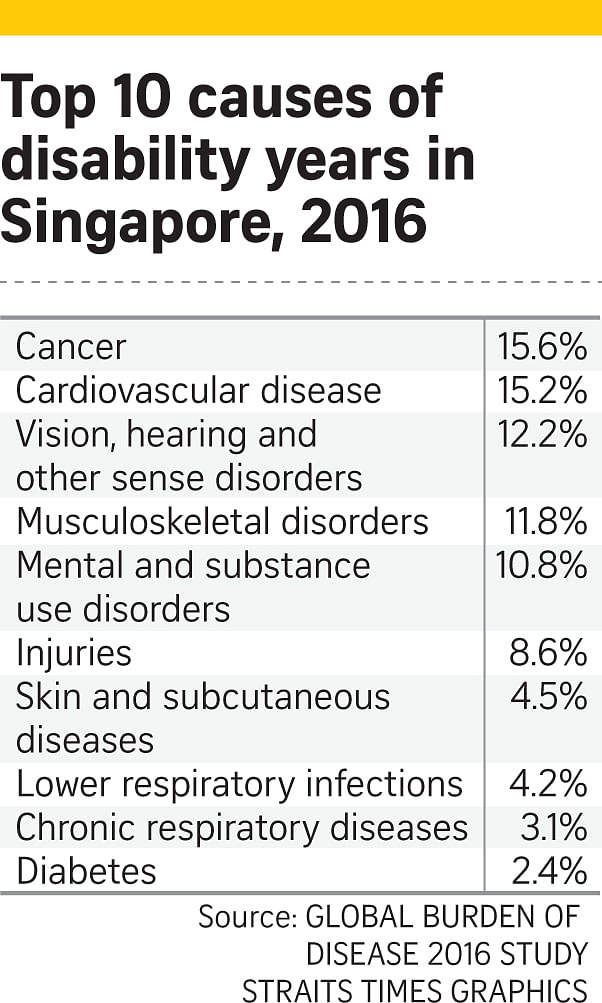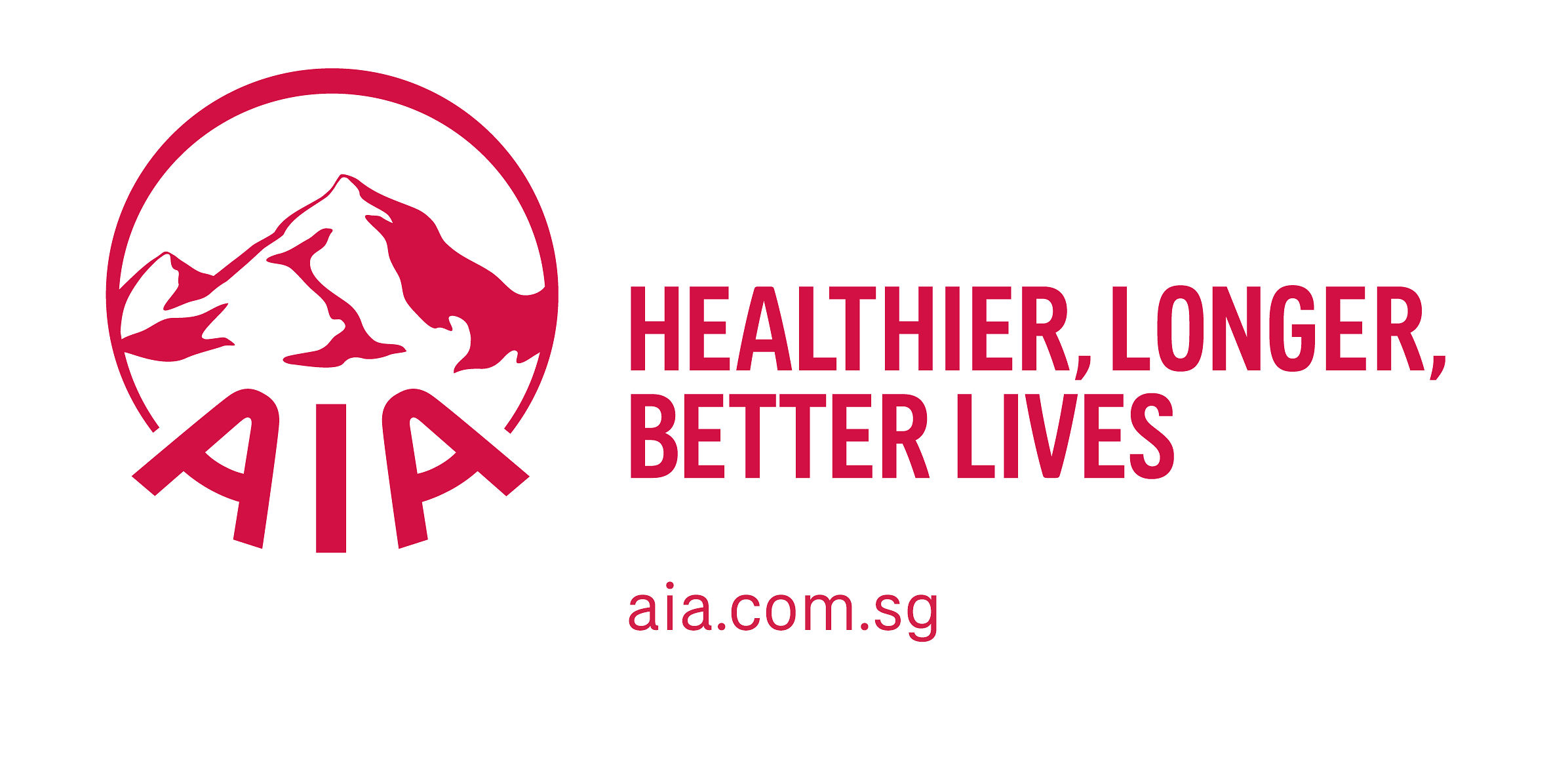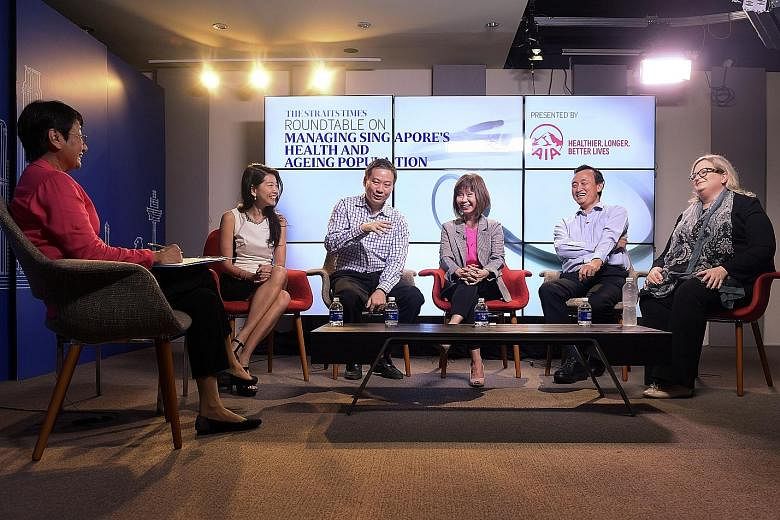A rapidly ageing population is no cause for despair. This was the shared view of the five panellists in the Straits Times-AIA Roundtable on "Managing Singapore's Health with an Ageing Population: What more needs to be done?"
Singapore has already put many things in place preparing for the time, in the not too distant future, when one in four people here is over the age of 65 years.
But more can be done to ensure that older people get the care they need and the country does not suffer as a result.
Essentially, the panellists pointed out that being old is not the problem. Being sick, at any age, is.
So one important thing to do is to keep people here in good health for as long as possible.
Preparing for old age has to start when they are young, be it staying healthy for as long as possible, or ensuring that they will be financially independent.
-
THE PANELLISTS:
-
DR AMY KHOR, Senior Minister of State for Health
MS MELITA TEO, chief operating officer of AIA
DR JEREMY LIM, partner at Oliver Wyman
PROFESSOR CHIA KEE SENG, Edpidemiologist, Saw Swee Hock School of Public Health
MS SIGAL ATZMON, chief executive officer of Medix
-
THE MODERATOR:
SALMA KHALIK, ST Senior Health Correspondent
The second thing is that older people, if they remain healthy, can remain in the workforce for longer, adding to the nation's productivity.
Thirdly, no matter what we do, people will fall sick. With an older population, the number of people who do need healthcare will go up.
This raises the question of whether the cost of healthcare here will remain affordable as the pool of people who require care increases. At the same time, are there enough facilities and people to look after them?
BLUEPRINT FOR AGEING SOCIETY
Dr Amy Khor, Senior Minister of State for Health, said the ministerial committee for ageing had launched the action plan for successful ageing in 2015.
"The idea is that it's a blueprint to prepare for a rapidly ageing society," she said.
It is a multi-pronged approach on what the different sectors in Singapore can do to make things better with its rapidly ageing population.
There are preventive health and active ageing programmes targeted at the individual.
There is also the Silver Academy that offers seniors more than 900 courses that they can take up. So far, about 21,000 learning places have been taken up. This includes some people going for more than one course.
At the community level, there is now barrier-free access for the mobility impaired, as well as safer traffic junctions which give the elderly more time to cross the streets.
There are also community befrienders who reach out to older people living alone who might be at risk of social isolation.
Trained Silver Generation Ambassadors visit those who turn 65 years old to find out if they have needs and to provide any referral if necessary.
Said Dr Khor: "I think few places in the world, if any, does this. It is being done systematically, and not on an ad hoc basis.
The Health Ministry has also been bumping up the infrastructure, such as hospitals, nursing homes and day care facilities.
For day care, the vacancies are more than the wait list, said Dr Khor. "It's just where (the services are)... The waiting time for nursing homes has also been reducing, and we are increasing capacity."

But, he said: "It certainly doesn't mean that we are ready. And in truth, I think we will never be ready."
Dr Khor said the action plan "is a living document".
She added: "We have to build up on it and as we implement programmes, we learn and we refine and implement other new programmes that may be useful."
Professor Chia Kee Seng, an epidemiologist at the Saw Swee Hock School of Public Health, said the tendency, not just here but globally, is to focus on the current aged and see all the problems they pose.
While this is important, the conversation needs to be enlarged to include younger people who will age in future. "We will forever be behind the curve if we are just focusing on the current aged and the current sick," he said.
Plans for a successful ageing population must start with people in their 40s, if not even younger.
Prof Chia said younger people are pursuing wealth at the expense of their health. Unless that changes, their health as they age will suffer.
Ms Melita Teo, chief operating officer of insurance firm AIA agreed, saying that is why insurance companies encourage policy holders to start living healthy lives from as young as possible.
They should also screen for illnesses so they are aware of health problems and are thus able to prevent them from becoming chronic.
Singapore has introduced an enhanced screen for life where Singaporeans aged 40 years and older can screen for up to five conditions for $5 or less. The price includes the follow-up consultation with a doctor.
Ms Teo suggested: "Enforcement or that tracking, like 'Oh uncle, this year you're supposed to go and do this screening, you haven't done it', you know, that level of enforcement or encouragement, would be extremely helpful."

HEALTHIER FOR LONGER
All these efforts have resulted in Singaporeans spending more of their lives in good health.
Women here can expect to live more than 75 years in the pink of health, and men, 72 years of good health, before diseases hit, said Dr Khor.
In 1990, the average number of healthy years men here had was 65.1 years and women, 68.5 years.
What this means is that in just under 30 years, men are now enjoying 6.9 more years in good health and women remain healthy for 6.7 years more.
Singapore's life expectancy has been increasing steadily over the years. Today, it stands at 80.7 years for men and 85.2 years for women.
Prof Chia fully expects to see life expectancy at birth cross 90 years in the foreseeable future.
He said the longer healthy years of people here is probably due to the delay in onset of chronic diseases as well as better control of such ailments. The problem is not old age but sickness.
With an ageing population, we are going to have higher prevalence of people with diabetes. But he asked: "But so what, right? As a diabetic, I can manage. As a hypertensive, I can manage. It's a question of how can I be well even though I'm ill."
Dr Lim suggested: "Technically, if we can increase health span, commensurate with increase in lifespan, then the years spent in disability remain the same, and healthcare cost should not increase dramatically."
Dr Khor agreed, saying: "The idea really is to delay frailty for as long as possible."
She added: "If we do a lot more preventive health programmes, it will benefit them and will also reduce the demand on healthcare.
"That will change the whole mindset about ageing, that you should look at it positively. You embrace it because you can make better use of your longer life years."
The latest Global Burden of Disease study found that Singaporeans spend the fewest years with disabilities. She said: "It's actually very low. It's now lower than Japan."
Dr Khor also expects the seniors of the future will be very different from the elderly today. There is greater health awareness among the younger people.
There is already a visible difference between the Pioneer Generation who were born before the 1950s, and the newly coined-Merdeka Generation born in the 1950s, she said.
"I think with this generation, there is a good chance that if we do a lot more preventive health programmes, it will benefit them and actually, will also reduce the demand on healthcare," she said.
She added: "But having said that, we do need to prepare because the population is going to age, low fertility rates for instance, longevity, so whatever you say, there will be higher and higher proportions of seniors.
"But the good thing, of course, is that they have healthier life years for longer."
Prof Chia said the Merdeka Generation has a very different mindset from the Pioneer Generation: "It's no longer about retirement. It's more a question of how can I continue to contribute?"
BIAS AGAINST OLDER WORKERS
One stumbling bloc is the cultural bias against older people. That is not at all helpful as Singapore faces a rapidly ageing population, said Dr Lim. And the "Government is not blameless" in reinforcing the stereotype, he said.
"Some of the structural issues around employment and so on do not project the necessary positive image that we want."
But Dr Khor pointed out that the Government has extended re-employment age from 65 years to 67 years. She said: "We now have a committee reviewing this, looking at the issue of retirement age, looking at how we can provide better support to seniors who want to continue to work, flexible work, part-time work and so on."
Dr Lim, however, felt that retirement age itself should be extended beyond 62 years, not just the re-employment age.
"We really should define retirement age as life expectancy for your cohort minus whatever number of years that is appropriate to live in retirement," he argued.
That's because that is what "drives the age at which CPF monies can then be withdrawn and so on", he said.
Dr Khor disagreed.
Yes, there is some ageism and bias against older workers.
But with the current manpower constraints, more employers are looking at modifying jobs so older employees can continue working.
"More are taking up job redesign grants," she noted.
Prof Chia said: "We tend to have that stereotype that someone who is sick, someone who is aged is useless."
He said just because an older worker has a chronic ailment "doesn't mean that this person is now completely helpless or useless", even if his level of productivity may be lower.
Ms Teo said her company does not give up on employees who are sick. Should someone in the company have cancer, for example, she said: "We give them no-pay leave, let them go away and rest, treat themselves, and then at a certain time, in a few months, one year, we let them come back.
"We want them to come back and be well."
She added: "A person who is experienced but is not very well still has a lot more value to bring than someone who is just starting out of school."
Ms Sigal Atzmon , chief executive officer of Medix, said: "Research has proven that retiring too early is not healthy, that working as long as you physically and mentally can is actually healthy."
COST OF HEALTHCARE
Ms Atzmon and Ms Teo called for greater government oversight of the private healthcare sector.
Ms Atzmon said Singapore's public hospitals are among the best in the world, but "the private sector, unfortunately, is way more expensive, lengths of stays are much longer, bills are very high and there's no transparency".
About 80 per cent of patients are cared for in the public sector, but the amount spent in each sector is about the same, she said, and "doesn't reflect the number of beds".
She added: "If we work on reducing unwarranted healthcare variations, and implement the relevant measures, manage lengths of stays, et cetera, research globally indicate the average reduction on cost would be around 30 per cent."
Ms Teo chipped in to point out that just looking at patients going for unspecified gastritis, in the private sector, procedures would be done on 93 per cent, with 70 per cent undergoing more than one procedure.
In contrast, 77 per cent of public hospital patients with unspecified gastritis undergo procedures with only 29 needing more than one procedure done.
She added: "There's a lot of clinical governance that can be exercised more robustly in the private sector, because two patients can be very different but the variance in clinical procedures should not be this much."
Dr Lim pointed out that the private sector is a very heterogeneous group that spans the whole gamut from individual practitioners to very large group practices. The fault is with the outliers, and not the entire sector.

Nevertheless, Ms Teo said, unnecessary medical treatments in the private sector is inflating cost. AIA is concerned as a major provider of MediShield Life Integrated Plans (IPs) which cover private hospital care.
"At AIA, we truly believe that the IPs should be a national scheme in which insurers should not strive to make big profits, but only very modest surplus that helps to reinvest in better service improvements.
"But now all of us are losing money. So it's obviously not sustainable," said Ms Teo.
Dr Amy Khor reminded everyone that the MOH has recently stepped in to try to slow the double-digit increases in private healthcare claims against IP insurers.
It has, for one thing, stopped the sale of full riders where patients do not need to pay a cent for their treatment. It is generally felt in the industry that this is a major driver in the escalation of healthcare cost, especially in the private sector.
The ministry will also be coming out with fee benchmarks later this year for various procedures.
Ms Teo lamented that the benchmarks are unfortunately voluntary and not compulsory. She asked: "If there is some help to make it consistent across the board in terms of adoption by the private sector in particular, I think that would help."
Dr Khor then pointed out that insurance companies can pre-authorise treatments, instead of just paying whatever charges doctors bill them for.
Ms Atzmon said pre-authorisation is common practice in most countries: "You would not get a dollar paid back with most insurance companies without pre-authorisation."
Ms Teo agreed, adding that in Malaysia, 90 per cent of treatments paid for by insurance are pre-authorised. That came about with the insurance association working together with the health ministry.
The Life Insurance Association, Singapore is hoping to do the same here, she said.
Said Dr Khor: "We definitely encourage you to do it!"
104 and still going strong
At 104, Madam Tan Chwee Cheng still goes out for a stroll every morning and evening in her Simei neighbourhood , though the walks are shorter than when she was a few decades younger.
She is one of 1,300 people here who are over the age of 100. There are another 16,500 nonagenarians, or residents aged 90-99 years.
Madam Tan comes from a long-lived family. Her brother died at the age of 102 and her mother was 99 when she died.
She has had a fall three times in the past 15 years, but had bounced back - with rehabilitation at a community hospital - to continue living the life she wants.
One of her 12 grandchildren, AIA chief operating officer Melita Teo, recalls the days growing up, when her grandmother looked after her and her siblings while her parents were at work. "She cooked for us and tried to keep us disciplined. She also shared her family history and experiences, such as her time working on a rubber plantation," said Ms Teo.
She added that her grandmother used to cook very good Teochew dishes. "She was very creative in coming up with her own recipes, including a yam paste dish, and her dishes were very popular with those who tasted them."
Madam Tan used to help her husband run a mobile chin chow drink stall, and she would also sew to help make ends meet.
She gave up sewing to take care of Ms Teo and her siblings, but would make patchwork blankets and pillows for them.
Because her gums are now weak, she cannot wear dentures, so food has to be soft. But that has not kept her from her favourite food, and she eats chocolates and sweets every day.
Some weeks back, she was enjoying mooncake, as it was the season of the mid-Autumn festival.
She has been taking a shot of the fortified wine, DOM Benedictine, every day for decades. Sometimes more than once a day, said Ms Teo, because she would forget that she had already taken her shot.
She now lives with a daughter, one of her six children. Altogether, Madam Tan has 12 grandchildren and 11 great-grandchildren.
She remains active, spending two to three days a week on church activities. Her family also takes her out. But for those outings, she needs a wheelchair.
Salma Khalik



